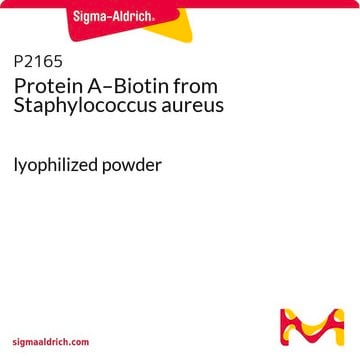P3775
Anti-Protein A antibody produced in rabbit
fractionated antiserum, lyophilized powder
Synonym(s):
Anti-Protein A
Sign Into View Organizational & Contract Pricing
All Photos(1)
About This Item
Recommended Products
biological source
rabbit
Quality Level
conjugate
unconjugated
antibody form
fractionated antiserum
antibody product type
primary antibodies
clone
polyclonal
form
lyophilized powder
packaging
vial of 2 mL lyophilized antiserum
technique(s)
indirect ELISA: 1:100,000
storage temp.
2-8°C
target post-translational modification
unmodified
Related Categories
General description
Protein A is a 42 kDa bacterial protein. It is isolated from the cell wall of Staphylococcus aureus.
The fractionation procedure yields primarily the immunoglobulin fraction of antiserum. To ensure specificity the fractionated antiserum is adsorbed using solid phase techniques, if necessary. Rabbit Anti-Protein A is lyophilized from 0.01 M phosphate buffered saline, pH 7.2, to which no preservatives have been added. Identity and purity of the antibody is established by immunoelectrophoresis. Electrophoresis of the antibody preparation followed by diffusion versus anti-rabbit IgG results in a single arc of precipitation and versus anti-rabbit whole serum results in multiple arcs of precipitation.
Immunogen
Protein A from Staphylococcus aureus
Application
Anti-Protein A antibody produced in rabbit has been used in immunoblotting.
Protein A may be used as in immunoblotting with a minimum dilution of 1:50,000.
Biochem/physiol Actions
Protein A has an ability to bind Fc region of immunoglobulins from several species. It is used as a “universal tracer” and it facilitate the segregation of bound and free ligand. Protein A also acts as affinity matrices for antibody (IgG) purification.
Physical form
Lyophilized from 0.01M phosphate buffered saline, pH 7.2
Reconstitution
Reconstitute with 2 ml deionized water.
Disclaimer
Unless otherwise stated in our catalog or other company documentation accompanying the product(s), our products are intended for research use only and are not to be used for any other purpose, which includes but is not limited to, unauthorized commercial uses, in vitro diagnostic uses, ex vivo or in vivo therapeutic uses or any type of consumption or application to humans or animals.
Not finding the right product?
Try our Product Selector Tool.
control
Product No.
Description
Pricing
Storage Class Code
11 - Combustible Solids
WGK
WGK 3
Flash Point(F)
Not applicable
Flash Point(C)
Not applicable
Personal Protective Equipment
dust mask type N95 (US), Eyeshields, Gloves
Certificates of Analysis (COA)
Search for Certificates of Analysis (COA) by entering the products Lot/Batch Number. Lot and Batch Numbers can be found on a product’s label following the words ‘Lot’ or ‘Batch’.
Already Own This Product?
Find documentation for the products that you have recently purchased in the Document Library.
Customers Also Viewed
Ritu Gupta et al.
PloS one, 10(7), e0132350-e0132350 (2015-07-07)
Saccharomyces cerevisiae Sub1 is involved in several cellular processes such as, transcription initiation, elongation, mRNA processing and DNA repair. It has also been reported to provide cellular resistance during conditions of oxidative DNA damage and osmotic stress. Here, we report
Regulation of yeast G protein signaling by the kinases that activate the AMPK homolog Snf1
Clement ST, et al.
Science Signaling, 6(291), ra78-ra78 (2013)
Smriti Kala et al.
PloS one, 7(10), e46864-e46864 (2012-10-12)
Most mitochondrial mRNAs in trypanosomatid parasites require uridine insertion/deletion RNA editing, a process mediated by guide RNA (gRNA) and catalyzed by multi-protein complexes called editosomes. The six oligonucleotide/oligosaccharide binding (OB)-fold proteins (KREPA1-A6), are a part of the common core of
Radioimmunoassay
Immunoassay, 269-285 (1996)
Cell cycle-dependent phosphorylation and ubiquitination of a G protein alpha subunit
Torres MP, et al.
The Journal of Biological Chemistry, 286(23), 20208-20216 (2011)
Our team of scientists has experience in all areas of research including Life Science, Material Science, Chemical Synthesis, Chromatography, Analytical and many others.
Contact Technical Service













